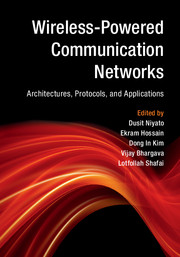Book contents
- Frontmatter
- Contents
- List of contributors
- Preface
- Part I Basics of Wireless Energy Harvesting and Transfer Technology
- Part II Architectures, Protocols, and Performance Analysis
- 4 Cooperative Networks with Wireless Energy Harvesting
- 5 Multiple Antennas and Beamforming for SWIPT Systems
- 6 Backscattering Wireless-Powered Communications
- 7 Dedicated Wireless Energy Harvesting in Cellular Networks: Performance Modeling and Analysis
- 8 Ambient Wireless Energy Harvesting in Small Cell Networks: Performance Modeling and Analysis
- Part III Applications of Wireless Energy Harvesting and Transfer
- Index
- References
8 - Ambient Wireless Energy Harvesting in Small Cell Networks: Performance Modeling and Analysis
from Part II - Architectures, Protocols, and Performance Analysis
Published online by Cambridge University Press: 01 December 2016
- Frontmatter
- Contents
- List of contributors
- Preface
- Part I Basics of Wireless Energy Harvesting and Transfer Technology
- Part II Architectures, Protocols, and Performance Analysis
- 4 Cooperative Networks with Wireless Energy Harvesting
- 5 Multiple Antennas and Beamforming for SWIPT Systems
- 6 Backscattering Wireless-Powered Communications
- 7 Dedicated Wireless Energy Harvesting in Cellular Networks: Performance Modeling and Analysis
- 8 Ambient Wireless Energy Harvesting in Small Cell Networks: Performance Modeling and Analysis
- Part III Applications of Wireless Energy Harvesting and Transfer
- Index
- References
Summary
Introduction
Small cell networks (SCNs) are envisioned as a key enabling feature of next-generation wireless networks that can meet the high capacity requirements in outdoor/indoor environments [1]. The successful implementation of SCNs faces several challenges. For instance, the increase in co-channel interference (CCI) due to densification of small cells can significantly degrade the achievable network capacity. Moreover, the subsequent increased energy consumption of the system is undesirable from both environmental and economical perspectives. Finally, providing grid power to all small cell base stations (SBSs) may not always be feasible due to their possible outdoor/remote/hard-to-reach locations.
Thanks to the recent advancements in wireless energy harvesting (EH) techniques, it has become feasible to power small devices wirelessly. Wireless EH thus enables dense deployment of SBSs irrespective of the availability of power grid connections. It is important to note that dedicated EH leverages the deployment of dedicated energy sources. Therefore, additional resource/power consumption is unavoidable [2]. Consequently, ambient EH is crucial to reduce the grid power consumption of cellular networks. Unfortunately, owing to the dependence of energy harvested from renewable energy sources on temporal/geographical/environmental circumstances, consistent performance at the base stations (BSs) may not be guaranteed. Also, harvesting energy from renewable energy sources may require an extra hardware setup of solar panels and/or wind turbines. Thus, the significance of investigating other kinds of ambient sources in order to minimize the grid power consumption of cellular networks becomes evident.
Motivated by the aforementioned facts, in this chapter, we focus on RF-based ambient EH small cell networks and highlight the corresponding challenges from implementation and operation perspectives. These challenges arise due to factors such as nondeterministic energy arrival patterns, EH mode selection, energy-aware cooperation among base stations, etc. Next, we provide a brief overview of the existing literature in the context of the challenges discussed. The review provided highlights the research gaps and points out future research directions. Finally, we investigate the performance of a K-tier uplink cellular network where cellular users harvest RF energy from the concurrent downlink transmissions from all network tiers. Then, each user stores the harvested energy in an attached battery until the amount of energy stored therein is sufficient to perform channel inversion power control.
- Type
- Chapter
- Information
- Wireless-Powered Communication NetworksArchitectures, Protocols, and Applications, pp. 265 - 288Publisher: Cambridge University PressPrint publication year: 2016



